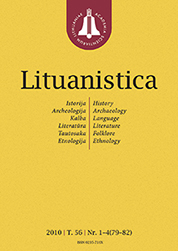LituanisticaWHAT?
 ISSN 0235-716X |
2005 m. Nr. 1 Tarminis kalbėjimas: (galimi?) socialiniai
kalbėjimų koreliatai
The article attempts to reason the division between the appellative and dialectal speech with the help of social speech habit correlates. Concerning the regional speech variety, the social aspect indicates the social characteristics of dialects. On the one hand, as regards the dialectal speech variety, the social criterion is not the most important one, though on the other hand, especially nowadays, it indicates extra values to the language analysis. The attempt to link dialects with the sociostructures is motivated by the theory of language and culture isomorphy, that is, the language conforms to the society and certain language means conform to each individual’s social status. Each social role has its own repertoire of language means, sometimes a certain social role satisfies dialectal or half–dialectal speech. Other social indexes, for example, education, age, may also be interrelated to the habits of dialectal or half-dialectal speech. The article analyses the empirical data gathered in Lyduokiai district (Ukmergė region) and the findings of a sociolinguistic inquiry. The respondents that belong to the lower layers of society, uneducated or having poor education, use a more dialectal speech in which the features common to the Highlanders anykštėnai are sustained. And vice versa, the respondents of a higher social status, having better education, prefer speaking the appellative language (or half-dialectal speech). Such a situation is determined by objective factors: the social roles of the members that belong to the lower layers of society, uneducated or having poor education are almost unmarked officially. People of this social status use everyday communication, and the period of their studies was too short to develop the habit of the appellative language. Besides, what concerns the elder people, the fact that teachers used dialectal speech while teaching them should be taken into consideration.
|
Numeriai:
2011 - T.57 Nr.1, Nr.2, Nr.3, Nr.4 2010 - T.56 Nr.1-4 2009 - T.55 Nr.1-2, Nr.3-4 2008 - T.54 Nr.1, Nr.2, Nr.3, Nr.4 2007 - T.53 Nr.1, Nr.2, Nr.3, Nr.4 2006 Nr.1, Nr.2, Nr.3, Nr.4 2005 Nr.1, Nr.2, Nr.3, Nr.4 2004 Nr.1, Nr.2, Nr.3, Nr.4 2003 Nr.1, Nr.2, Nr.3, Nr.4 2002 Nr.1, Nr.2, Nr.3, Nr.4 2001 Nr.1, Nr.2, Nr.3, Nr.4 |